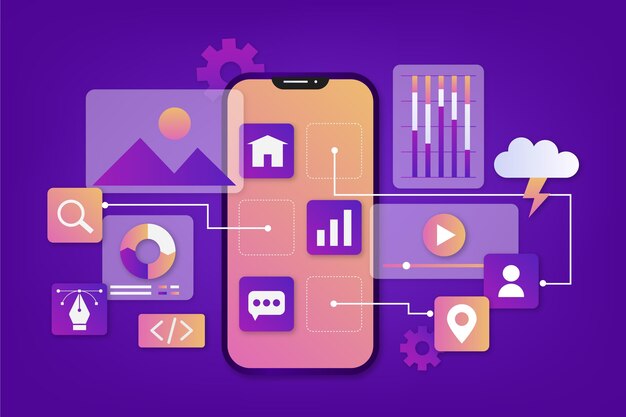A look at “8 StepsTo Make Your First $1000 Building Apps Without Coding” In this article, I’ll share a step-by-step guide on how to make your first $1,000 by building apps for people as a freelancer without ever writing a single line of code.
No-code app development started as a thing of a hobby for many people, and earlier last year, I got to know of no-code app development.

and how many businesses are taking advantage of no-code app developers to build web and mobile apps
This year, I got to work closely with a no-code agency that offers the service to people!
Purely building apps for big businesses without coding!
Thus proving that building apps without coding is a concept that you can use to start generating good money- up to $3000+ within the next 3 months.
What Do We Mean By No-Code Apps?
No-code apps refer to applications that can be created and developed without the need for traditional programming or coding skills.
These apps are built using visual interfaces, drag-and-drop functionality, and pre-built components or templates provided by no-code development platforms.
Instead of writing lines of code, users can simply assemble and configure different elements to create fully functional applications.
No-code app development empowers you as an individual with limited technical expertise or coding knowledge to bring an app idea to life.
By such doing, the barrier of learning programming languages is eliminated, making app development accessible to you.
With no-code platforms, users can focus on the app’s design, user experience, and functionality, rather than the intricacies of coding.
How No-Code App Building Works?
No-code platforms typically provide a visual interface where you can select and customize various components, such as buttons, forms, databases, and integrations.
These platforms often offer a range of features, including data storage, user authentication, APIs, and deployment options to app marketplaces.
Why You Will Make Good Money From Building No-Code Apps?
Reason 1: Speed and Efficiency
No-code apps allow businesses to develop and deploy applications quickly.
The visual interface and pre-built components streamline the development process, eliminating the need to write code from scratch.
This results in faster time-to-market, enabling businesses to meet their operational or customer demands as quickly as possible.
Also, if businesses are testing out an idea, let’s say for example, with a minimum viable product, no-code app building allows them to do this very fast!
Reason 2: Cost-Effectiveness
Developing custom-coded apps is often very expensive, as it requires skilled developers and extensive coding efforts.
In contrast, no-code apps significantly reduce development costs by eliminating the need for dedicated coding resources.
Since every business owner would love to get the same results for lesser expenses, most businesses prefer no-code app building
It allows businesses to allocate their budgets more efficiently, and invest more in other critical areas.
Reason 3: Flexibility and Agility
No-code platforms provide businesses with the flexibility to adapt and iterate their applications as their market requirements change.
With visual interfaces and drag-and-drop functionality, modifying their app components or adding new features becomes available to even their non-technical staff.
This agility allows businesses to respond quickly to market trends, customer feedback, and evolving needs.
8 Steps To Make Your First $1,000 Building Apps Without Coding
Step 1: Determine Your App Development Niche
Identify the type of apps you want to specialize in building.
It could be mobile apps for small businesses, educational apps, productivity apps, eCommerce apps or any other niche that interests you.
Focusing on a specific niche will help you become an expert in that area and this will attract clients looking for app development services in that specific niche.
Step 2: Acquire Skills In App Development Tools
Explore no-code or low-code app development platforms that require minimal coding knowledge.
Some popular options include Bubble, Adalo, and Thunkable.
Research and compare the features, pricing, and user reviews of different platforms to find the one that suits your needs best.
Step 3: Build Your Portfolio
Create a portfolio website or a dedicated section on your existing website to showcase your app development skills.
Include screenshots or interactive prototypes of apps you have built using your chosen platform.
If you don’t have any client projects yet, create sample apps to demonstrate your capabilities and creativity.
Step 4: Define Your Pricing Structure
Determine how you will price your app development services.
You can charge per project, per hour, or a combination of both.
Consider factors such as the complexity of the app, the estimated time required for development, and the value you bring to the client’s business.
Research industry standards and competitor pricing to set a competitive rate.
Step 5: Find Clients (or Do Clients Acquisition)
Start by leveraging your existing network and reaching out to friends, family, and acquaintances who might need an app developed.
Utilize social media platforms, freelance marketplaces like Upwork or Fiverr, and online communities relevant to your target audience to promote your services.
Create engaging content related to app development on platforms like LinkedIn and Medium to establish yourself as an authority in your niche.
Step 6: Communicate and Collaborate with Clients
When you find potential clients, initiate discussions to understand their app requirements and objectives.
Use project management tools like Trello or Asana to keep track of tasks, deadlines, and client communications.
Maintain clear and regular communication with clients throughout the app development process to ensure alignment and client satisfaction.
Step 7: Deliver High-Quality Apps
Utilize your chosen app development platform to build functional and visually appealing apps that meet your clients’ needs.
Pay attention to details, test the app thoroughly, and fix any bugs or issues before delivering the final product.
Aim for a seamless user experience and ensure the app meets the agreed-upon specifications.
Step 8: Provide Ongoing Support
Offer post-launch support to your clients by addressing any issues or updates that may arise.
Providing exceptional customer service and timely responses will help you build long-term relationships with your clients and potentially lead to referrals or repeat business.
Conclusion
By following these steps and continuously honing your app development skills, you can start making up to $3,000 every month by building apps for people as a freelancer without coding.
Remember to continuously improve your knowledge and stay updated with the latest app development trends to stay competitive in the field.









Leave a Reply